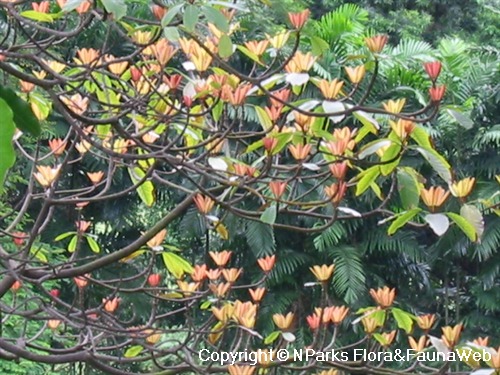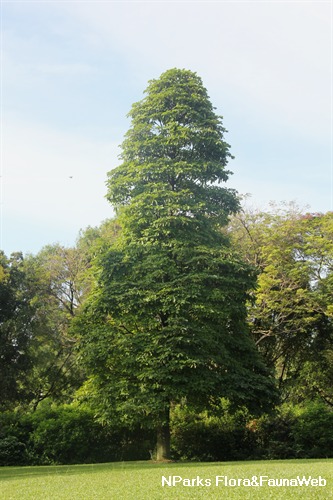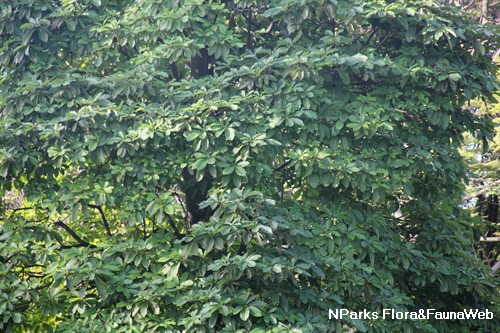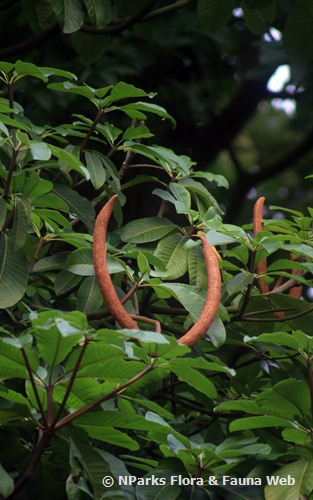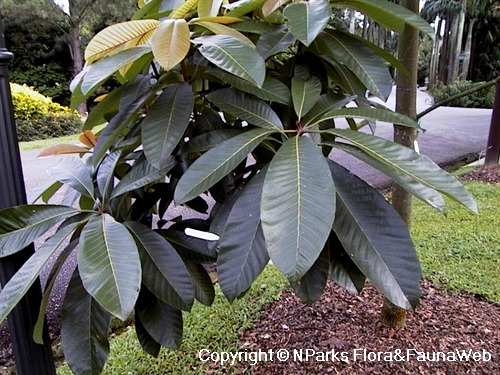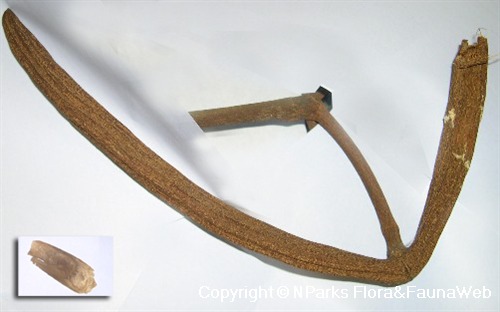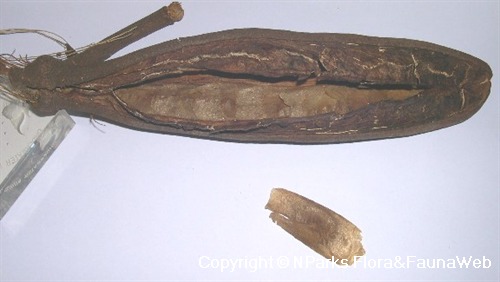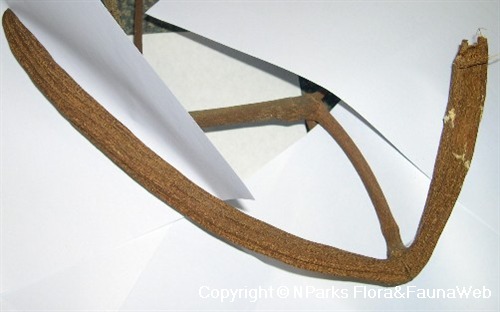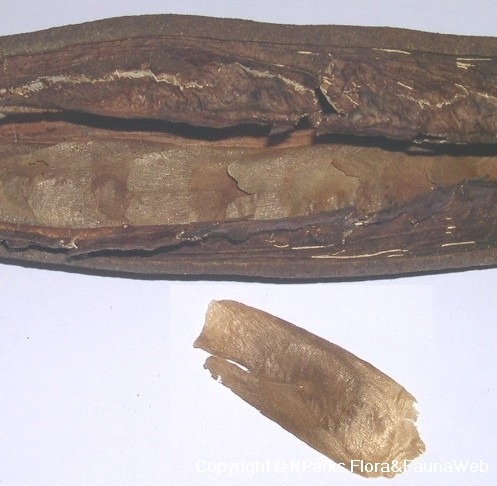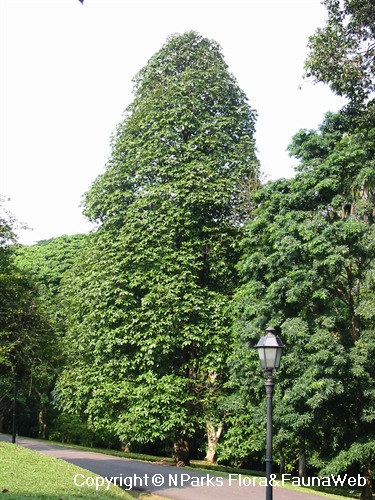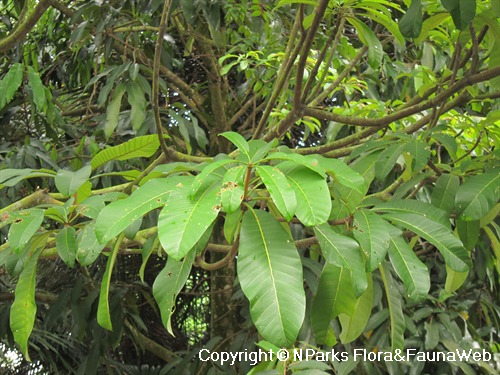-(9).jpg)
Back
Dyera costulata (Miq.) Hook.f.
| Family Name: | Apocynaceae |
| Synonyms: | Alstonia costulata Miq. |
| Common Name: | Jelutong, Jelutung, 日落洞 |
Dyera costulata or Jelutong is a native tree of Singapore that grows up to 80 m tall. It has whorled leaves, flowers are 5 petalled, white, yellowish-green or pinkish-yellow in colour. The fruit is a paired, woody follicle up to 40 cm long, splits upon maturity releasing flattened elliptic seeds with a membranous wing.
Name
Classifications and Characteristics
| Plant Division | Angiosperms (Flowering Seed Plants) (Dicotyledon) |
|---|---|
| Plant Growth Form | Tree (Big (>30m)) |
| Lifespan (in Singapore) | Perennial |
| Plant Shape | Tiered, Irregular |
| Maximum Height | 80 m |
Biogeography
| Native Distribution | Southern Thailand, Sumatra, Peninsular Malaysia, Singapore, and Borneo |
|---|---|
| Native Habitat | Terrestrial (Primary Rainforest, Secondary Rainforest, Freshwater Swamp Forest) |
| Preferred Climate Zone | Tropical, Sub-Tropical / Monsoonal |
| Local Conservation Status | Native to Singapore (Vulnerable (VU)) |
Description and Ethnobotany
| Growth Form | It is a large emergent tree with dark grey, brown to black bark that grows to 80 m tall, with somewhat exposed roots. |
|---|---|
| Crown | Distinctly tiered when young, but turns irregular when mature. |
| Foliage | Leaves are in whorls of 4 - 8, stipules found at the tip of the branches, 3 - 6 mm long. The leaves are leathery to papery, spoon-shaped, oblong to elliptic, with round-toothed margins, measuring 5.5 - 42 cm long by 1.8 - 14 cm wide. |
| Flowers | Flowers are arranged in whorls along the flowering shoot between 4 - 18 cm long. The flowers are 5-petalled, tubular, white, yellowish-green or pinkish-yellow. They bloom at night between 5 - 7 pm and fall off by the next morning. |
| Fruit | The fruit is a long, heavy, woody follicle 18 - 40 cm long that comes in a pair. It splits upon maturity releasing flattened elliptic seeds, each with a broad membranous wing. |
| Habitat | Occurs in lowland dipterocarp forest. |
| Associated Fauna | Its flowers are insect-pollinated. |
| Cultivation | It can be propagated by seed. |
| Etymology | The genus, Dyera was named after Sir William T. Thiselton-Dyer - a English botanist and former director of the Royal Botanic Gardens, Kew. The species epithet refers to costulatus, finely ribbed possibly in reference to the ribbed twigs. |
| Ethnobotanical Uses | Timber & Products: The tree was formerly tapped for rubber and chewing gum. Presently, the wood is still valued for its commercial light hardwood timber called Jelutong. Cultural / Religious: Heritage Tree: There is currently 1 individual of Dyera costulata listed as Heritage Trees in Singapore. The tree can be found in Singapore Botanic Gardens. To find out more about this tree, please visit the Heritage Tree Register. |
Landscaping Features
| Landscaping | It is suitable for parks and streetscapes for its attractive form. |
|---|---|
| Desirable Plant Features | Ornamental Form |
| Landscape Uses | Suitable for Roadsides, Parks & Gardens, Shade Providing Tree / Palm |
Fauna, Pollination and Dispersal
| Pollination Method(s) | Biotic (Fauna) |
|---|---|
| Seed or Spore Dispersal | Abiotic |
Plant Care and Propagation
| Light Preference | Full Sun, Semi-Shade |
|---|---|
| Water Preference | Moderate Water |
| Plant Growth Rate | Moderate |
| Rootzone Tolerance | Moist Soils, Well-Drained Soils, Fertile Loamy Soils |
| Maintenance Requirements | Moderate |
| Propagation Method | Seed |
Foliar
| Foliage Retention | Evergreen |
|---|---|
| Mature Foliage Colour(s) | Green |
| Mature Foliage Texture(s) | Papery, Leathery |
| Prominent Young Flush Colour(s) | Red |
| Foliar Type | Simple / Unifoliate |
| Foliar Arrangement Along Stem | Whorled |
| Foliar Attachment to Stem | Petiolate |
| Foliar Shape(s) | Non-Palm Foliage (Elliptical, Oblong, Obovate) |
| Foliar Venation | Pinnate / Net |
| Foliar Margin | Crenulate |
| Foliar Apex - Tip | Acuminate, Rounded |
| Foliar Base | Cordate, Rounded / Obtuse |
| Leaf Area Index (LAI) for Green Plot Ratio | 3.0 (Tree - Intermediate Canopy) |
Non - Foliar and Storage
| Stem Type & Modification | Woody |
|---|---|
| Root Type | Underground (Tap Root) |
Floral (Angiosperm)
| Flower & Plant Sexuality | Bisexual Flowers , Bisexual Flowers |
| Flower Colour(s) | Cream / Off-White, White, Pink, Yellow / Golden |
|---|
| Flower Grouping | Cluster / Inflorescence |
| Flower Location | Axillary |
| Flower Symmetry | Radial |
| Individual Flower Shape | Tubular |
| Inflorescence Type | Cyme |
| Flowering Opening Time | Night (dusk to dawn) |
| Flowering Habit | Polycarpic |
Fruit, Seed and Spore
| Mature Fruit Colour(s) | Brown |
|---|---|
| Fruit Classification | Simple Fruit |
| Fruit Type | Dehiscent Dry Fruit , Follicle |
References
| References | Middleton, D.J. & Rodda, M. (2019). Dyera. In: Apocynaceae. Flora of Singapore, vol. 13. Singapore: Singapore Botanic Gardens, National Parks Board. |
|---|
Image Repository
Others
| Master ID | 1573 |
|---|---|
| Species ID | 2866 |
| Flora Disclaimer | The information in this website has been compiled from reliable sources, such as reference works on medicinal plants. It is not a substitute for medical advice or treatment and NParks does not purport to provide any medical advice. Readers should always consult his/her physician before using or consuming a plant for medicinal purposes. |

-(7).jpg)
-(8).jpg)
